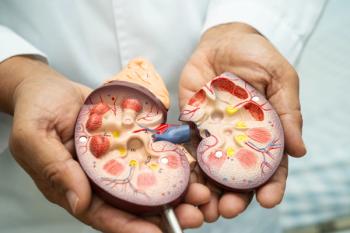
Managing Safety and Supportive Care With Pluvicto: Insights From the PSMAddition Trial
Scott Tagawa, MD, professor of medicine and urology at Weill Cornell Medicine, discusses safety and tolerability findings observed to date, renal and hematologic considerations, and the role of pharmacists.
The phase 3 PSMAddition trial is evaluating the use of lutetium Lu 177 vipivotide tetraxetan (Pluvicto) in combination with standard-of-care therapy for patients with metastatic castration-sensitive prostate cancer. In this interview, Scott Tagawa, MD, professor of medicine and urology at Weill Cornell Medicine, discusses safety and tolerability findings observed to date, renal and hematologic considerations, and the role of pharmacists in optimizing care and ensuring safe outpatient administration of radiopharmaceutical therapy.
Q: What safety or tolerability findings from PSMAddition are most relevant for pharmacists, especially regarding hematologic toxicity, renal effects, and supportive care needs?
Scott Tagawa, MD: Constitutional symptoms are common across all studies, often manifested as fatigue. The most frequent additional adverse events are partly associated with areas of target expression—what we call “on-target but off-tumor” effects—such as in the salivary glands, lacrimal gland, and small intestine. These may present as dry mouth and gastrointestinal changes, including nausea, vomiting, constipation, or diarrhea.
There is PSMA expression in the proximal renal tubule, and most small molecules are renally excreted, making the kidney an at-risk organ. Fortunately, across phase 3 studies to date, there has been no major renal failure signal. However, it’s still early; even though PSMAddition has the longest safety follow-up so far, the primary efficacy end point only extends to about 2 years, so late effects could emerge.
If a patient presents with preexisting renal dysfunction, we need to monitor closely. Because this is a renally excreted drug, the amount of circulating radiation will persist longer in those patients. We also need to be aware of potential myelosuppression—if someone has a creatinine clearance of around 30, the drug can still be administered per SNMMI and EANM criteria for mCRPC, but closer monitoring for myelosuppression is warranted.
The pattern of myelosuppression differs somewhat from chemotherapy, both in timing and in which blood counts are affected. The nadir typically occurs 3 to 4 weeks after administration. Anemia is most common, though neutropenia and thrombocytopenia can also occur. Compared with chemotherapy, there tends to be more thrombocytopenia and less neutropenia, but these events are usually grade 1 or 2. Still, patients who begin treatment with low platelets or low counts for other reasons need careful monitoring before each cycle.
Q: Were any patient or disease characteristics associated with greater benefit from Pluvicto?
Tagawa: In PSMAddition, all subset analyses so far have favored early use of lutetium PSMA therapy. We haven’t yet been able to conduct deep analyses by individual subsets or biomarkers, so right now, the observed benefit appears consistent across the population. Of course, it’s unlikely that everyone benefits equally. We look forward to future exploratory analyses to identify biomarkers that may predict which patients are more or less likely to benefit—both would be useful insights.
Q: What considerations should pharmacists keep in mind regarding coordination of radiopharmaceutical handling, radiation safety, and patient education for outpatient administration?
Tagawa: This regimen includes 3 drugs. I won’t focus on the LHRH or GnRH therapy and the ARPI, though pharmacists are certainly involved in those. Typically, only radiopharmacists handle the radioactive product, and they are well-versed in safety protocols.
One key difference with radioligand therapy is that other people—not just the patient—can be exposed to radiation. We tell patients not to handle ARPIs, for example, and to avoid skin exposure. With radioligands, however, the radiation is emitted from within the patient, especially during the first few days post-administration. While the overall risk is low, safety depends on time and distance—the further away someone is and the shorter the exposure, the lower the risk.
Radiation is also excreted in the urine. Although the amount is small compared with what remains in the patient, the urine lacks natural shielding. The first several voids carry higher radioactivity, so patients should flush carefully and take precautions if incontinence is an issue. These aspects are different from most standard drug regimens and require appropriate education and coordination.
Q: How do you foresee the PSMAddition results influencing future sequencing or combination strategies across the prostate cancer continuum, and what role can pharmacists play in optimizing these regimens?
Tagawa: Generally, we try to use each drug once—ADT aside, since that’s continuous. We know from experience that docetaxel, for example, can be reused, but typically, we don’t return to the same agent once we move on.
If Pluvicto is used earlier, it’s less likely to be used again later, and other treatment options may take precedence. Pharmacists can play an important role by helping clinicians keep track of available therapies and their sequencing.
While drug-drug interactions are less of a concern with small-molecule radioligands, we do need to be mindful of combinations with oral agents and pre-existing organ dysfunctions. These aren’t always contraindications—Pluvicto can be administered even to patients on dialysis with proper precautions—but renal excretion and possible myelosuppression or hepatotoxicity warrant close attention. Pharmacists are essential partners in monitoring and managing these factors to optimize safety and outcomes.
Newsletter
Stay informed on drug updates, treatment guidelines, and pharmacy practice trends—subscribe to Pharmacy Times for weekly clinical insights.


















































































































































































































